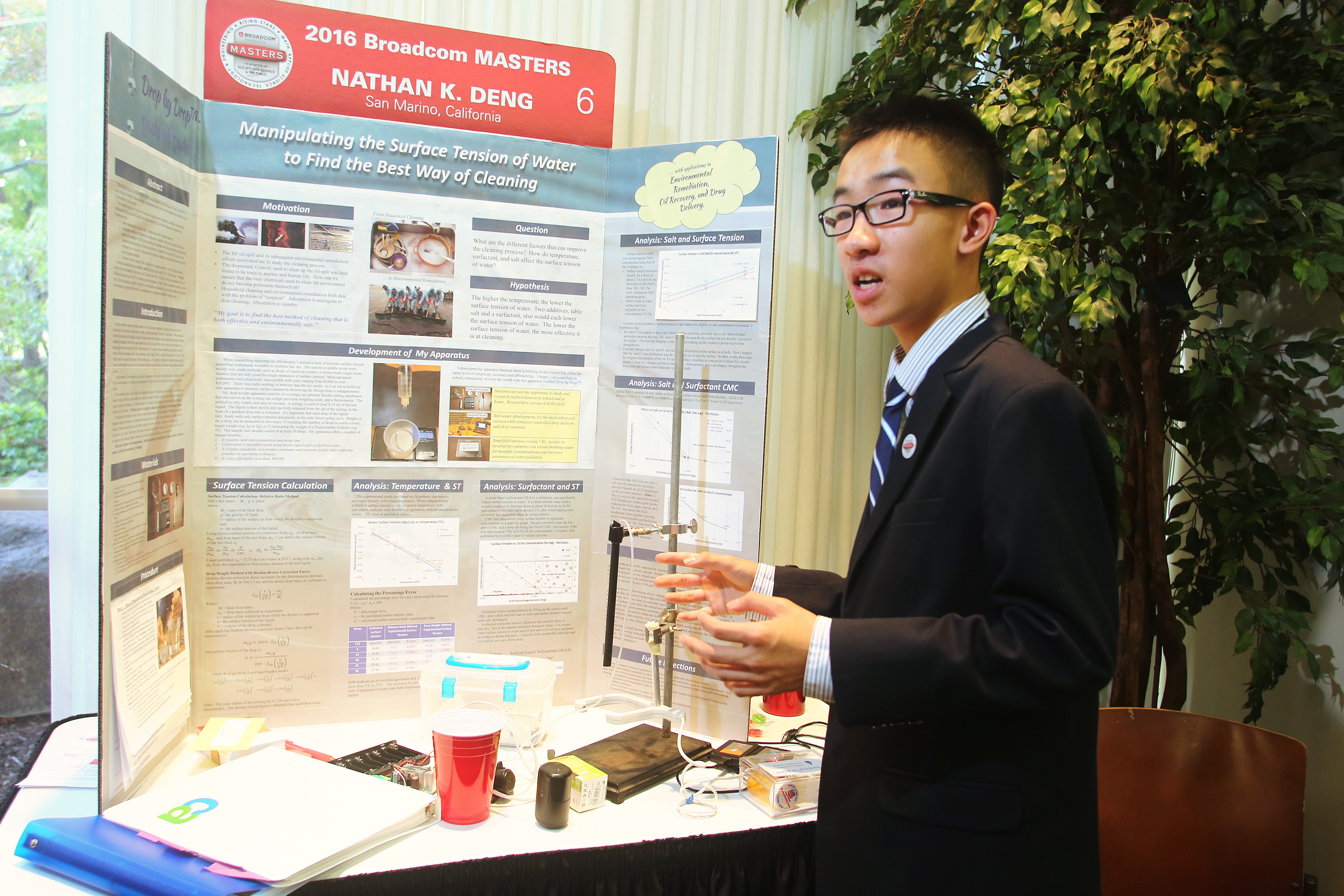The trials and errors of inventing

One middle school student found a sustainable way to clean up oil spills. Nathan Deng, a 2016 Broadcom MASTERS top winner, found that existing surfactant measuring options are crude or costly. So he invented a cheaper tool.
Now, Nathan is working on packaging his surface tension kits for students and people in developing countries. He’s also figuring out how to educate people on using the device.
Read on to learn more about Nathan’s continued research, and how to keep going even when your invention doesn’t work on the first, second, or third time.
Inventing is a process of trial and error, and your idea almost certainly wouldn’t work for the first, second, or third time.
HOW HE STARTED INVENTING: When I started developing my apparatus for my science project, I wasn’t even thinking about invention. I was just trying to find a substitute for the expensive instrument (stalagmometer) that I couldn’t afford. I had no idea if my simple apparatus was going to work. But it was worth a try because I studied the principle of drop weight and my idea of using a syringe should work the same way as the more expensive stalagmometer to measure surface tension.
It worked well enough for me to complete my middle school science project. But when I first tried to use my apparatus to find the critical micelle concentration (CMC) of surfactant solution, it failed to yield consistent data. I found that the professional laboratory typically uses a much more expensive precision equipment to find CMC. I thought to myself, “Am I wasting my time?” My little apparatus would never have that kind of precision.
Even my father doubted that my apparatus was going to work (for surfactant). But he encouraged me to keep trying. “You can find the problem and improve it,” he said. After many trials and errors and refinements, I was able to determine the CMC of sodium lauryl sulfoacetate using a syringe-tubing plus a few kitchen tools. I was elated and excited, but still had doubts. “Can it be a coincidence? Is my procedure repeatable? Are my calculations correct?” I wondered.
I asked my father to run a few test trials to make sure it was repeatable by another person. To check my calculation, I utilized two different methods of calculating surface tension using my collected data, and when the results from the two methods agreed, I was finally satisfied. In a way, I accidentally invented an accurate but affordable surface tension-measuring apparatus that can potentially benefit others.
I accidentally invented an accurate but affordable surface tension-measuring apparatus that can potentially benefit others.
The most difficult part is not inventing the product itself, but rather how to market and distribute it to users. For example, how big is the market for my invention? How do I get it into people’s hands? Will they use it? How do I provide user education and support to ensure its success? These are the problems I am trying to tackle now for my invention.
WHAT IS THE MOST DIFFICULT PART OF RESEARCH? THE BEST PART: The best part of inventing is the process of turning an idea into a working prototype or product that solves a real-world problem and improves people’s lives in some way. Of course, inventing is a process of trial and error, and your idea almost certainly wouldn’t work for the first, second, or third time.
You may experience moments of frustration and self-doubt. Sometimes you may have to shelve the initial idea altogether and try something else. It may not sound like the “best” part, but it really is because those are the moments that make the whole inventing experience worthwhile and you learn so much along the way. It’s especially rewarding if you can collaborate with other people, exchange ideas, and come up with new options for your invention.
The best part of inventing is the process of turning an idea into a working prototype or product that solves a real-world problem.
CURRENT STEM PROJECTS: At home, I am working on how to package my surface tension kits for students and people in developing countries. I’m trying to understand how other people may use my kit, and how to provide personalized user education and user support when I am not available. Taking advantage of the growing use of cell phones, social media, and the Internet, I am working on inventing a virtual companion tutor that utilizes artificial intelligence to teach users how to use my apparatus and some of the science behind it.
I am working on how to package my surface tension kits for students and people in developing countries.
In school, I am member of the Solar Energy Activity Laboratory team sponsored by Caltech. I am working with a team of students in my school and two Caltech graduate students to find metal oxides semiconductors that, by absorbing sunlight (solar energy), can aid in the splitting of water molecules into hydrogen and oxygen. This method can create hydrogen fuel as a promising form of renewable energy.
Broadcom MASTERS galvanized my passion for STEM and helped me become a more effective team member.
THE IMPORTANCE OF SCIENCE COMPETITIONS LIKE BROADCOM MASTERS: Broadcom MASTERS has given me tremendous confidence and courage to tackle new problems. It also galvanized my passion for STEM and helped me become a more effective team member.


